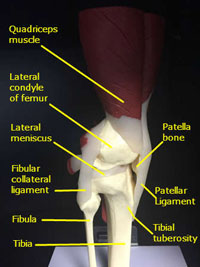Chondromalacia patella is a common condition affecting runners or jumpers. The patella is a small bone that transmits forces from the quadriceps to the tibia. Running and jumping places tremendous amounts of stress on the patella tendon, which transmits that force through the patella bone. During a normal jumping motion, the knee bends and straightens during the explosion stage, and the legs absorb the forces as the body lands. Much of the force travels through the patella tendon and patella.
Under normal circumstances, the patella bone slides comfortably in a groove on the femur. However, running and jumping can cause injury to the quadriceps muscle which results in the medial (inside) of the quadriceps weakening, causing the lateral (outside) muscles to spasm. This causes the patella to shift towards the outside of the knee. The groove was not designed for this type of movement, and there is increased rubbing and grinding of the patella surface on the femur.
Thankfully, the patella bone and the femur both have cartilage on the joint surfaces, which normally reduces friction and irritation during knee flexion and extension. However, as the patella surface shifts to the side and friction is increased, the cartilage becomes irritated and injured. Injury to the patella cartilage is called chondromalacia patella.
Chondromalacia patella is commonly treated with physical therapy modalities including heat, ice, electric, ultrasound, stretching, and exercise. As mentioned before, the inside part of the quadriceps becomes weak and the outside becomes spasmodic. Strengthening focuses on increasing the inside aspect of the quadriceps muscle, or vastus medialis. Stretching and lengthening emphasis is placed on the outside the quadriceps, or vastus lateralis. Running gait mechanics may be addressed if a poor gait is causing unnecessary stress on the knee and contributing to the chondromalacia patella. Proprioceptive or balance exercises are also commonly incorporated into a treatment plan.
Cold Laser Therapy Treatments
1. ACCELERATED TISSUE REPAIR AND CELL GROWTH
Photons of light from lasers penetrate into tissue and accelerate cellular growth and reproduction. Laser therapy increases the energy available to the cell so it can work faster, better, and quickly get rid of waste products. When cells of tendons, ligaments, and muscles are exposed to laser light they repair and heal faster.
2. FASTER WOUND HEALING
Laser light increases collagen production by stimulating fibroblasts. Collagen is the building block of tissue repair and healing. Laser therapy increases fibroblast activity and therefore collagen production to speed healing.
3. REDUCED FIBROUS TISSUE FORMATION
Low level laser therapy decreases scar tissue formation. Scar tissue can be a source of chronic pain and poor healing. By eliminating excessive scar tissue and encouraging proper collagen production, painful scars and chronic pain is reduced.
4. ANTI-INFLAMMATION
Laser therapy causes vasodilatation (increases size of capillaries) which increases blood flow. The treatments also increases lymphatic drainage to decrease swelling or edema. Therefore, laser therapy reduces swelling caused by bruising or inflammation while speeding the recovery process.
5. PAIN RELIEF
Cold laser therapy decreases pain by blocking pain signals to the brain. Some nerve cells sense pain and send signals to the brain. Chronic pain can be caused by overly active pain nerves. Specific wavelengths help “shut off” the pain signals, thereby; eliminating your pain.
6. INCREASED BLOOD FLOW
Blood carries nutrients and building blocks to the tissue, and carries waste products away. Increased blood flow to tissues increases and enhances cellular healing. Cold laser therapy increases the formation of capillaries in damaged tissue. Specific laser frequency also increases blood flow to the area treated, to enhance injury repair.
7. INCREASED REPAIR AND REGENERATION
Low level lasers increases enzyme activity to improve metabolic activity that affects cell repair and regeneration. The enzymes are turned on “high” to speed the healing.
8. NERVE FUNCTION AND REPAIR
Nerves heal very slowly. Lasers speed up this process. Damage to nerves causes numbness, pain, muscle weakness, and altered sensations. Laser therapy treatments enhance nerve function, healing, and reduce pain.
9. INCREASED ENERGY PRODUCTION – ATP
ATP is like gasoline for cells, it is the energy source that cells operate. Injured cells often have low levels of ATP, which decreases their ability to heal and repair. By increasing ATP and “gasoline storage levels,” cells have more ATP for healing and repair. Increased mitochondrial production is very important with nerve pain.
10. ACUPRESSURE AND TRIGGER POINTS
Low level laser therapy decreases trigger points and stimulates acupuncture points to decrease muscle and joint pain.
We combine low level laser therapy with a variety of techniques and treatments. Cold laser therapy can be used alone as a single treatment modality, or in conjunction with other Chiropractic, Physical Therapy, massage therapy, or medical treatments.
for more details contact us or Email: info@healthpluspt.com
- Address: 2114 Oak Tree Rd, Edison, NJ 08820
- Phone: 732- 494-5999
- Fax: 732-494-5994

